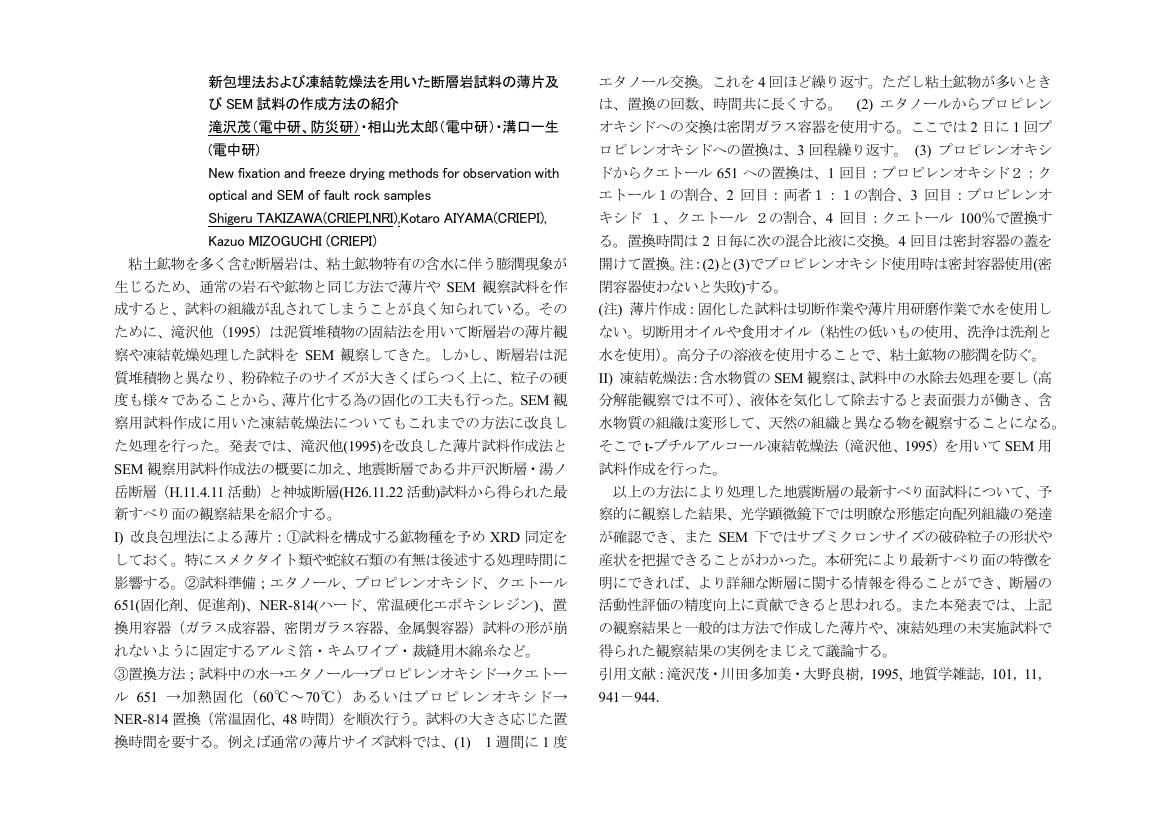- 著者
- 溝口 一生 上田 圭一
- 出版者
- 電力中央研究所
- 雑誌
- 電力中央研究所報告. 研究報告. 電力中央研究所地球工学研究所 編
- 巻号頁・発行日
- no.11041, pp.1-17,巻頭1-3, 2012-04
We have been conducting meter-scale rock friction experiments using the large-scale shaking table at NIED since 2012. We have completed 5 series of experiments, each of which included about 20 experiments. One of the purposes of these experiments was to investigate the spatial scaling of the friction since the friction laws we use today were derived from centimeter-scale experiments. Another purpose was to monitor rupture evolution and local stress field using near-fault high-resolution measurements. In this talk, we will showcase some key results derived from our rock friction experiments.Regarding the spatial scaling of friction, we recognized that the local frictional strength was not uniform on the fault and its spatial variation had a significant impact to the macroscopic frictional strength (Yamashita et al., 2015). In addition, the scaling behavior seems different between rock-on rock friction and that with a gouge layer. In the rock-on-rock case, gouge generation changes the strength in space. But if the gouge layer already exists, strength depends on the rearrangements of the gouge particles (Yamashita et al., 2018).Regarding rupture evolution on laboratory fault, we pointed out a previously overlooked difficulty in direct measuring the two-dimensional (2D) evolution of the rupture front. Under very special condition, we could overcome this difficulty by installing 2D strain gauge arrays inside the rock sample. We found that the free surface effects at both edges of the fault had a significant effect on rupture nucleation (Fukuyama et al., 2018). In addition, the strain behavior close to the fault edge might not be the same as that on the fault, even if the sensors were installed within 10 mm away from the fault. Using numerical simulations, we could reproduce the observed strain data by extrapolating a simple friction behavior on the fault surface, suggesting that the way of deriving the friction law needs to be revised (Xu et al., 2019).We also discovered some interesting fault behaviors during our experiments. By changing loading rate or fault surface condition, we could frequently reproduce super shear rupture events in the laboratory, which were thought to be rare in nature. By investigating the cohesive zone length of the rupture front in the supershear regime, we showed that the experimental results could reach a good match with one of the theoretical predictions Fukuyama et al. (2017). Moreover, we observed slow slip events with supersonic propagation velocity during some experiments (Fukuyama et al., 2019), whose interpretation is still underway.The above results bridge the gap between the traditional small-scale lab experiments and the field observations, and can be useful for improving our understandings of fault rheology and earthquake physics.
1 0 0 0 OA 新包埋法および凍結乾燥法を用いた断層岩試料の薄片及びSEM試料の作成方法の紹介
- 著者
- 滝沢 茂 相山 光太郎 溝口 一生
- 出版者
- The Geological Society of Japan
- 雑誌
- 日本地質学会学術大会講演要旨 (ISSN:13483935)
- 巻号頁・発行日
- pp.208, 2015 (Released:2016-03-31)
1 0 0 0 OA 大型岩石試料のスティックスリップ試験中に発生した前震活動
- 著者
- 辻村 優志 川方 裕則 福山 英一 山下 太 徐 世慶 溝口 一生 滝沢 茂 平野 史朗
- 出版者
- 日本地球惑星科学連合
- 雑誌
- 日本地球惑星科学連合2016年大会
- 巻号頁・発行日
- 2016-03-10
For inland earthquakes such as the 2007 Noto Hanto earthquake (Doi and Kawakata, 2013) and the 2008 Iwate-Miyagi earthquake (Doi and Kawakata, 2012), foreshocks were reported to occur in the vicinity of main shock hypocenter. Moreover, for interplate earthquakes such as the 2011 off the Pacific coast of Tohoku earthquake (Kato, et al., 2012) and 2014 Iquique earthquake in Chile (Yagi et al., 2014), migration of foreshocks toward the main shock hypocenter was detected in one month before the main shock. In order to understand the generation mechanism of foreshocks, it is important to investigate under what environments foreshocks occur.Since 2012, stick-slip experiments have been carried out using a large-scale biaxial friction apparatus at NIED (e.g., Fukuyama et al., 2014). Based on the experimental result that foreshocks were detected only in the later period of each run, Kawakata et al. (2014) suggested that the foreshocks occur only after the generation of gouge. In this study, we carried out a series of stick-slip experiments with and without pre-existing gouge along a fault plane to confirm if fault gouge affects the foreshock activity. When foreshocks are detected, we estimate the hypocenter locations of foreshocks.We used two rectangular metagabbro blocks to make the simulated fault plane, whose dimension was 1500 mm long and 500 mm wide. The experiments were conducted under normal stress of 1.33 MPa and loading speed of 0.01 mm/s up to approximate slip amount of 8 mm. During each experiment, we continuously measured elastic waves to detect foreshocks. The sensor distribution is shown in the figure below. Gouge materials were prepared naturally during preceding experiments whose sliding speed was as high as 1 mm/s.To roughly detect foreshock activity, we calculated cumulative amplitude of continuous waveform data every 0.01 seconds. During an experiment without pre-existing gouge materials (LB13-004), a few foreshocks were detected. On the other hand, during an experiment with pre-existing gouge materials (LB13-007), much more foreshocks were detected. Then we estimated hypocenters of foreshocks for a stick-slip event (event 44) in LB13-007. Although the initial phases of the main shock were contaminated due to the coda wave signals of preceding foreshocks, the hypocenter of the main shock was roughly estimated near the right end of the fault plane. Foreshocks began to occur in the left half of the fault plane, but most of later foreshocks occurred near the right end.Therefore, we confirmed that foreshock activity was high when gouge materials were present along a fault plane, and found a similar hypocenter migration of foreshocks toward the main shock hypocenter, which was reported for interplate earthquakes.In the future, we shall examine the data obtained from other experiments to confirm if the aforementioned features are common.Acknowledgments: This work was supported by NIED research project “Development of monitoring and forecasting technology for crustal activity” and JSPS KAKENHI Grant Number 23340131.
